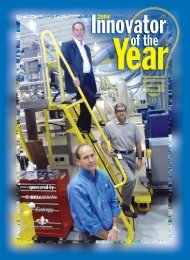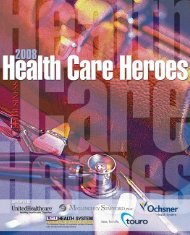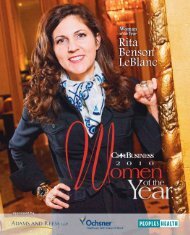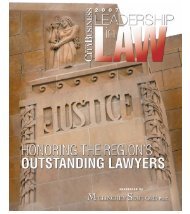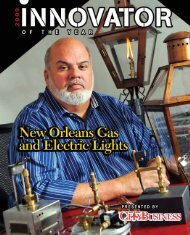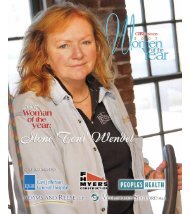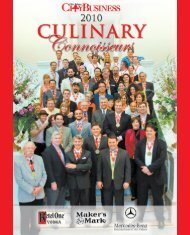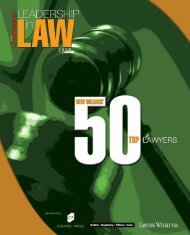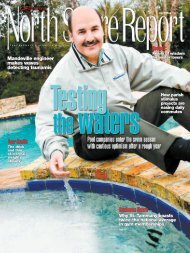We salute those who - New Orleans City Business
We salute those who - New Orleans City Business
We salute those who - New Orleans City Business
Create successful ePaper yourself
Turn your PDF publications into a flip-book with our unique Google optimized e-Paper software.
PHYSICIANWilliam JohnstonPosition: neurosurgeon, East Jefferson General HospitalAge: 63Family: wife, Rosalie; children, Allison Deviney, 34, Guy, 30Education: bachelor’s degree in botany, University of Southwestern Louisiana; doctor of medicine,Louisiana State University Medical Schoolphoto by Frank AymamiDr. William Johnston acknowledges popularperceptions of neurosurgery oftenmake people uncomfortable, particularlywhen it comes to something like removing abrain tumor.“I sometimes feel that way myself,”Johnston said.But in a career spanning about fourdecades, Johnston has made strides in tryingto make the mysterious and complicatedseem less so.“I think it accomplishes nothing bytelling a patient something they might like tohear but you know you can’t come throughwith. And almost without exception, I havefound if you look a person right in the faceand tell them the truth, which includestelling them what they can do about a particularsituation, they will do a lot better than ifyou try to sugarcoat something.”After graduating from medical school,Johnston set up a practice in <strong>New</strong> <strong>Orleans</strong>before going to work for East JeffersonGeneral Hospital, where he is now the chiefof neurosurgery.And while he has treated thousands ofpatients, Johnston said some cases are stillsobering.“Typically we have a pretty good idea fromour pre-operative images studies what theproblem is exactly,” Johnston said. “The challengeis then to do as much as you can for thepatient, to find as much good time as you can.”But there are a lot of brain tumors thatcan be removed completely with a very goodoutcome, Johnston said. Not long ago, heand his team saw a man <strong>who</strong> had a hugebenign tumor that occupied the front half ofhis brain cavity.“He had lost his job and was having allkinds of troubles,” Johnston said. “He wasn’tfunctioning properly. Finally, someonedid a scan of his head and the tumor was discovered.<strong>We</strong> removed it and he has donevery well.”•— Garry BoulardPHYSICIANLeslie LevensonPosition: interventional cardiologist, Heart Clinic of LouisianaAge: 63Family: wife, Gayle; children, Lisa, 37, Lauren, 20, Jonathan, 20Education: bachelor’s degree in biology, Boston University; doctor ofmedicine, University of Vermont Medical SchoolDr. Leslie Levenson examines awireless EKG with EmergencyMedical Technician Ryan Brown.After Hurricane Katrina, Dr. Leslie Levenson saw a lot ofhis colleagues leave the <strong>New</strong> <strong>Orleans</strong> area for other businessopportunities. He also had several offers to leave the cityand take his practice elsewhere.“But I never considered leaving,” Levenson said. “I likeit too much here, and the residents of this city, comingback and rebuilding their homes and their lives, that’s aninspiration to me. I wouldn’t want any other patientssomewhere else.”The 63-year-old has called the <strong>We</strong>st Bank of <strong>New</strong> <strong>Orleans</strong>home for 33 years as an interventional cardiologist at theHeart Clinic of Louisiana. He also said the shortage of cardiologistsin the <strong>New</strong> <strong>Orleans</strong> area helped solidify his decisionto maintain his practice.Levenson said he wanted to be a cardiologist since he wasa kid and was inspired by Dr. James Gault, chief cardiologistat Penn State University, <strong>who</strong> mentored him while he was afellow at the school.“He made me really excited about cardiology andinspired me to do more. He made me realize … that wecan give people all kinds of medications and do all kinds ofphoto by Frank Aymamidifferent surgeries on them, but they also have to helpthemselves and participate in their health care — exercisingright, eating right and living right. That’s what I teachmy patients.”Coronary disease causes one out of every five deaths inthe United States, and 60 million Americans have some formof cardiovascular disease, according to the American HeartAssociation. Levenson said improvements in medicine,including better stents to prop open arteries, have enabledhim to better perform open-heart procedures.“Advances in technology and surgical equipment havebecome a lot more sophisticated in the past five years.Everything is more user friendly, keeping vessels open forlonger periods of time, helping both the doctors and thepatients.”•— Tommy Santora<strong>New</strong> <strong>Orleans</strong> <strong>City</strong><strong>Business</strong> — May 25, 2009 25



